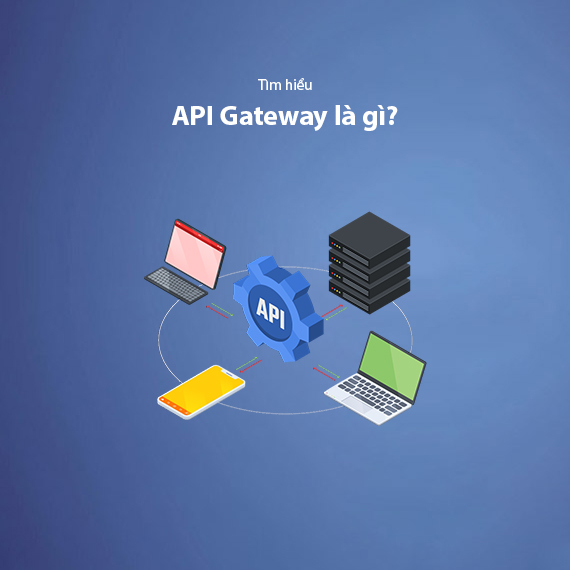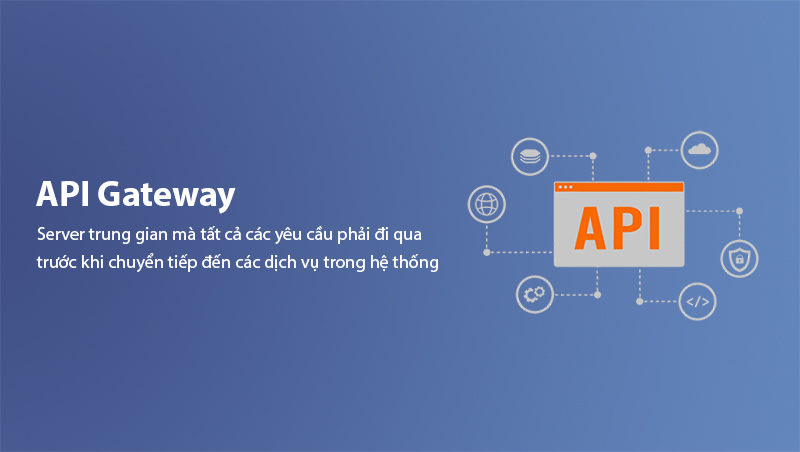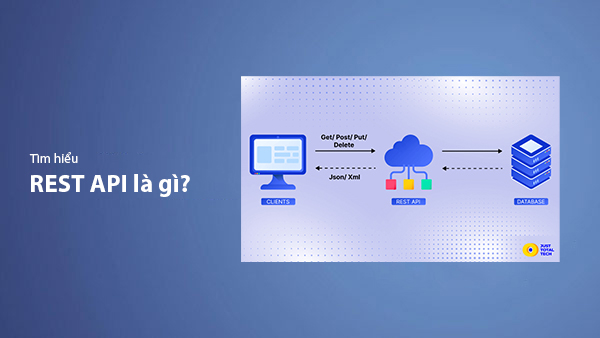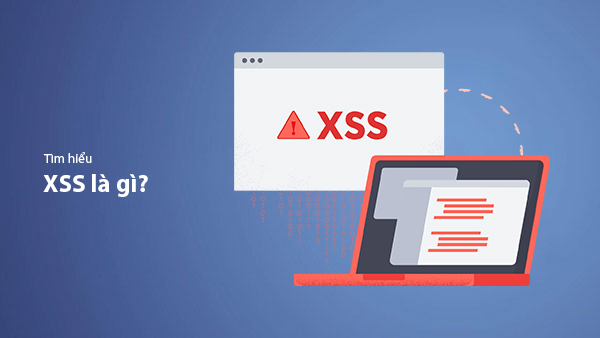Understanding What API Gateway Is and Its Role in Microservices Architecture
- Published on

What Is API Gateway?
In the context of modern application development, especially when using Microservices Architecture, one of the biggest challenges is how to make these small, independent services communicate effectively with each other. To solve this problem, API Gateway is used as an intermediary gateway, helping manage and coordinate all user requests to services within the system.
API Gateway is an intermediary server that acts as the "gate" through which all requests must pass before being forwarded to specific services in the system. This helps simplify communication between users and backend services, while also reducing the load on individual services by handling tasks such as authentication, load balancing, and logging at the API gateway.

API Gateway is not just a simple proxy but also an important layer in managing application programming interfaces (APIs), enhancing system security and performance. Popular tools that provide API Gateway solutions include Kong, Amazon API Gateway, Nginx, and Zuul.
Functions of API Gateway
API Gateway is not just a simple tool for forwarding requests; it also performs many important functions in operating and optimizing Microservices systems. Here are some key functions of API Gateway:
-
Traffic Management: API Gateway helps coordinate traffic between users and backend services. In this way, it can help load balancing, distributing requests to services appropriately, thus optimizing performance and ensuring system stability.
-
Authentication & Authorization: One of the most important functions of API Gateway is handling user authentication and granting access to services. This helps secure the system without having to repeat authentication code in each microservice.
-
Rate Limiting: API Gateway can limit the number of requests each user can send in a given period, to avoid system overload and protect backend services from DDoS attacks.
-
Logging & Monitoring: API Gateway has the ability to log and monitor all requests and responses between users and backend services. This helps developers easily track and analyze system performance.
-
Data Transformation: API Gateway can also perform data transformations between services. For example, it can convert data formats from JSON to XML and vice versa, allowing services to communicate with each other even if they use different formats.
Thanks to these functions, API Gateway has become an indispensable component in Microservices architecture, helping manage communication between services and improving the efficiency of the entire system.
How API Gateway Works
API Gateway acts as a single intermediary point between users and microservices in the system. When a request comes from a user, instead of accessing each service directly, the request is sent to the API Gateway, where it is processed and forwarded to the corresponding service. Here is the detailed working mechanism of API Gateway:
-
Receiving Requests: When a user sends a request (e.g., an HTTP request) from their application, the request is sent directly to the API Gateway instead of directly to the microservice.
-
Processing Tasks Before Forwarding: API Gateway will perform a series of tasks before forwarding the request to the appropriate service. These tasks may include user authentication, checking access permissions, rate limiting requests, and data transformation if necessary.
-
Forwarding the Request: After processing the necessary tasks, the API Gateway will forward the request to a specific microservice in the system. If the request requires results from multiple services, the API Gateway can call several services and aggregate the results before sending them back to the user.
-
Aggregating and Returning Results: After receiving responses from the backend services, the API Gateway can perform some processing like aggregating data, converting formats, or reducing the number of responses. Then, the results are sent back to the user, completing the communication process.
This helps the Microservices system maintain flexibility, scalability, and ease of maintenance, while minimizing the complexity of managing and securing communication between services. API Gateway is not just a tool for forwarding requests, but also a key component in controlling and optimizing data flows between users and services within the system.
Advantages and Disadvantages of API Gateway
API Gateway provides many benefits to Microservices systems, but there are also some drawbacks to be aware of. Below is a detailed analysis of the advantages and disadvantages of API Gateway:
Advantages of API Gateway
-
Centralized Management: API Gateway helps centralize the management of all user requests into a single point. This reduces the complexity of maintaining API access points for each individual service in the microservices system.
-
Better Security: API Gateway allows for centralized authentication and authorization. You only need to authenticate users at the API Gateway rather than implementing authentication in each service, thereby minimizing security risks and optimizing management.
-
Enhanced Performance and Resource Efficiency: API Gateway helps with load balancing and traffic management between services, improving performance and saving system resources. Instead of each service handling tasks like logging, security, or traffic control, the API Gateway performs these tasks at the intermediary level.
-
Easy Scaling: When there is a need to scale the system, API Gateway makes it easier to scale and add new services, as you only need to configure the API Gateway instead of changing each service individually.
Disadvantages of API Gateway
-
Single Point of Failure: Since the API Gateway is the only intermediary point between users and services, it becomes a single point of failure if not implemented correctly. If the API Gateway encounters an issue, the entire system could be affected. To mitigate this risk, there should be a failover strategy and load balancing.
-
Increased Input Load: Although the API Gateway helps reduce the load on backend services, it must handle all requests from users. This can increase the load on the API Gateway, especially in high-traffic systems. Optimizing the API Gateway to handle large volumes of requests is essential.
-
Complex Management: Integrating API Gateway into the system can introduce complexity in maintaining it, especially when supporting many different services. Configuring and monitoring the API Gateway requires considerable skill and initial investment.
Despite some drawbacks, API Gateway remains a crucial part of optimizing and securing Microservices systems. Understanding and leveraging the advantages of API Gateway correctly will help make your system stronger and more scalable.
When to Use API Gateway?
API Gateway is a powerful tool, but it's not always necessary. Deciding when to use API Gateway depends on the requirements and architecture of the system. Here are some common scenarios where you should consider using API Gateway:
-
Microservices Architecture: If your system is built on microservices architecture, API Gateway is an excellent solution for managing small, independent services. When you have many services that need to communicate with each other, API Gateway helps reduce the complexity of managing API endpoints and simplifies communication between services.
-
Traffic Management and Enhanced Security: If you need to manage traffic requests to your services, or need a centralized security solution for the entire system, API Gateway can help control request rates, implement authentication, and protect the system from DDoS attacks. When security is crucial or there is a large volume of traffic, API Gateway helps mitigate risks and enhance the system's defense capabilities.
-
Optimizing System Performance: In complex systems with many backend services and simultaneous user requests, API Gateway can improve overall system performance. With its load balancing and communication optimization capabilities, API Gateway helps distribute requests more efficiently, preventing backend services from being overloaded.
-
Easy Integration of Third-Party Services: If your system needs to integrate with external services or other systems, API Gateway can easily handle requests related to external APIs and transform data between your services and external services.
-
Centralized Management and Monitoring: When the system has many services, monitoring and logging requests can become challenging. API Gateway provides the ability to centralize logging and monitor all incoming and outgoing requests from the system, making it easier to track and detect issues.
In conclusion, if your system has complex requirements for API management, security, or performance, API Gateway is an indispensable tool. However, for simpler systems or when you're only using a few services, implementing API Gateway may not be necessary and could introduce unnecessary complexity.
Conclusion
API Gateway is an essential component in Microservices architecture, helping manage and optimize communication between small, independent services within the system. With its ability to manage traffic, authentication and security, load balancing, and centralized monitoring, API Gateway not only reduces complexity but also enhances the system's efficiency and security.
Although there are some drawbacks, such as the single point of failure and increased input load on the system, the benefits provided by API Gateway generally outweigh these challenges, especially in large, complex systems or when integrating with multiple external services. Using API Gateway allows the system to scale easily, maintain stability, and ensure optimal performance.
However, using API Gateway is not always the best choice for simple systems or applications that do not require Microservices architecture. Before implementing an API Gateway, you need to carefully evaluate the system's requirements and choose the appropriate solution.
Overall, API Gateway is a powerful and necessary tool in many scenarios, effectively managing and securing Microservices systems.
Latest Posts

Lesson 26. How to Use break, continue, and return in Java | Learn Java Basics
A guide on how to use break, continue, and return statements in Java to control loops and program execution flow effectively.

Lesson 25. The do-while Loop in Java | Learn Basic Java
A detailed guide on the do-while loop in Java, including syntax, usage, examples, and comparison with the while loop.

Lesson 24. How to Convert Decimal to Binary in Java | Learn Basic Java
A guide on how to convert numbers from the decimal system to the binary system in Java using different methods, with illustrative examples.

Lesson 23. How to Use the While Loop in Java | Learn Java Basics
Learn how to use the while loop in Java with syntax, real-world examples, and practical applications in Java programming.
Related Posts

What is REST API? Complete A-Z Knowledge About REST API
REST API is one of the essential concepts that every backend developer needs to fully understand. This article provides comprehensive knowledge about REST API, including its definition, principles of operation, and how to build a standard RESTful API.

What is HATEOAS? How to Build APIs Using HATEOAS
Learn about HATEOAS, an important concept in API development, and how to build APIs using HATEOAS to improve interactivity and scalability.

What Is GraphQL? The Advantages of GraphQL Over REST API
Explore GraphQL, a modern API technology, and why it outperforms REST API in many web development scenarios.

What is XSS? Signs of Detection and Effective Prevention Methods
Learn about XSS, signs of detection, and effective prevention methods for XSS attacks in websites.

